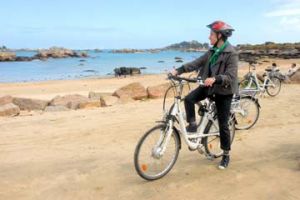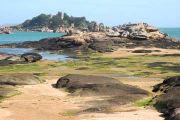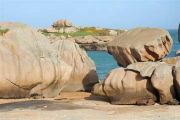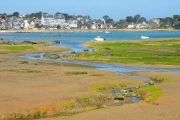 |

|
 Pink Granite Coast © T. Joly Pink Granite Coast © T. Joly

|
A new cycle route called “Tour de Manche” follows the northern Brittany coast and leads to many tourist sites. Focus on Trégor and the Pink Granite Coast, one of France’s most beautiful shorelines.
[ Practical ]
Getting there
- By road
360 km from Paris to Mont-Saint-Michel on autoroutes A13 and A84, 400 km till Saint-Malo.
450 km from Paris to Saint Brieuc on autoroutes A10, A81 and on N12, 535 km till Morlaix, 560 km till Roscoff.
- By train
TGV from Paris Montparnasse to Saint-Malo. The journey takes 3 h.
TGV from Paris Montparnasse to Saint-Brieuc and Morlaix. The journey takes between 3 h and 4 h.
TER trains from Guingamp to Lannion (30 mn).
Bus from Morlaix to Roscoff (30 mn).
- By plane
Hop ! flights from Paris Orly to Lannion.
Lodging
- Lannion
Hôtel Ibis
- Morlaix
Hôtel Saint-Melaine
- Perros-Guirec
Les Costans
Hôtel des Rochers
- Saint-Brieuc
Hôtel Edgar
- Trébeurden
Ti Al Lannec
- Trégastel
Hôtel de la Mer
- Tréguier
Kastell Dinec’h
Restaurants
- Lannion
Le Tire-bouchon
- Morlaix
Hôtel Saint-Melaine
- Perros-Guirec
La Clarte
La Crémaillère
- Trébeurden
Ti Al Lannec
- Trégastel
Les Triagoz
Bike rental
- Les Vélos Bleus
Tel : 0299403163
www.velos-bleus.fr
Information
- Bretagne Tourist Office
www.tourismebretagne.com
- Côtes d’Armor Tourist Office
www.cotesdarmor.com
- Finistère Tourist Office
Tel : 0298762564
www.finisteretourisme.com
- Ille-et-Vilaine Tourist Office
www.bretagne35.com
- Lannion Tourist Office
Tel : 0296056070
www.bretagne-cotedegranitrose.com
www.tourdemanche.com
If you want to discover the north of Brittany cycling, it is now very easy. Since June 2013 there is indeed a marked cycle route which runs almost all along the coast from the Mont Saint Michel to Roscoff. The section still missing, between Plougasnou and Morlaix, should be completed in 2014. Called Tour de Manche, it even goes till Cherbourg, at the northern tip of the Cotentin peninsula and in England, where it follows the south coast from Poole to Plymouth. A total length of over 700 km. Cyclists who want to travel on both countries can get from one to the other using the ferry services connecting Poole to Cherbourg, Saint-Malo to Weymouth via Jersey and Roscoff to Plymouth.

 Costaeres Castle © T.Joly Costaeres Castle © T.Joly
|
 Great tourist sites Great tourist sites
In Brittany, the Tour de Manche consists mainly of on-road sections with or without dedicated lane as well as a few traffic-free and quiet lanes sections. Nearly 250 km in length, it passes by several major tourist places. Cancale, a small fishing port that is famous for its oysters beds and seafood restaurants. The walled city of Saint-Malo. The seaside resort of Dinard, that boasts dozens of Belle-Epoque villas. Cap Frehel’s dramatic cliffs overlooking the sea about 70 meters. The port of Erquy, renowned for its scallops. The Bay of St-Brieuc where seaside resorts are interspersed with picturesque ports like Binic. Paimpol, a fishing town that is the gateway to the Brehat Island, called the “Island of Flowers”. The Pink Granite coast. The Bay of Morlaix, known for its imposing Taureau Castle and its myriad of little islands and islets that make up one of Brittany’s most important ornithology reserves.
Riders can do the whole length or break it up over a series of bite-sized trips as there are several railway stations all along the way where to start or end the journey.
 Electric bikes Electric bikes
Another option is to settle in one place and make loop rides from there to explore in detail the region.
Whatever your choice, the “Tour de Manche” website is of great help. It indeed lists all accommodations bearing the label “Accueil Vélo” meaning they make special provisions for cycling guests : early breakfasts, picnic lunches, bike parking and cleaning areas, basic repair kits, etc. In addition, it lists bike repairs and rentals. Among the latter, some of them like “Vélos Bleus” deliver and pick up bikes in the town of your choice and offer baggage transfers. Besides, a few municipalities have launched cheap bike rental services. For instance in the district of Lannion where electric bikes called Vélek’tro that are available in 7 tourist offices, 6 municipal campgrounds and one hotel for only €5 a day and €3 per half-day.

 Pink Granite Coast © T.Joly Pink Granite Coast © T.Joly
|
 Fantastically shaped rocks Fantastically shaped rocks
A good way to discover the Trégor, a region located in the North West of the Cotes d’Armor department that boasts a good choice of secondary cycling routes as well as many tourist sites. The most famous and most outstanding one is the Pink Granite Coast. Running from Trébeurden to Louannec, this thirty kilometers stretch of coast is scattered with rocky and sandy coves, safe fine sandy beaches edged by a turquoise sea and fantastically shaped rocks incredible pink in color that have been weathered by centuries of wind and tide. Close to the resort of Perros-Guirec, don’t miss the stunning seascapes near Ploumanach and the Saint-Guirec beach where an oratory stands on a rock surrounded by water at high tide. Around Trégastel have a look at several rocks famous for their strange shapes and nicknamed the “Die”, the “Witch” or the “Pile of Crèpes” as well as at the gothic style Costaeres castle built in the late 19th century atop a tiny islet just a few hundred meters off the coast where briefly lived Polish Henryk Sienkievicz, author of famous novel “Quo Vadis”.

 Pink Granite Coast © T.Joly Pink Granite Coast © T.Joly
|
 Bird sanctuary Bird sanctuary
In the same town, facing a beautiful beach, a sea life aquarium located in the midst of a pink granite outcrops offers a close-up look at the world of Brittany deep-sea life.
In addition, there are many off-shore islands some of which can be walked or waded to at low tide. The beautiful Ile Grande is even accessible via a bridge. A little further out are Les Sept Iles, an archipelago and a world-renowned sea-bird and seal sanctuary. Over 25,000 pairs of birds nest on those islands such as puffin, cormorant, guillemot, herring gull and gannet.
If you want to see more of the Brittany shoreline you can keep on going eastward towards the Côte d’Ajoncs, less touristy and wilder, whose highlights include the picturesque half-buried chapel of Port-Blanc, the Hell’s Bay and Le Gouffre’s stunning scenery near Plougrescant.
But Tregor is not all about the sea. There is also a lot to see hinterland. For instance a 14th century tide mill and the Traouiero, two deep wooded valleys scattered with pink granite rocks and home to rare species of moss and ferns.
 Megalithic monuments Megalithic monuments
Like everywhere in Brittany, there are many megalithic monuments. Among the most interesting, let’s name the Kerguntuil dolmen and grave gallery or the imposing 7.5 m high Saint Uzec menhir, dating back from four to five thousands years BC and christianized in the 17th century by the addition of a cross and catholic symbols. The adjacent Saint Uzec Chapel is one of the numerous religious buildings and calvaries visible in the area. A surprising sight, near Pleumeur-Bodou an enormous white dome rises above the trees. Called Radôme, it protects a huge antenna that, in 1962, achieved the first live televised link-up by satellite between the United States and Europe. Now part of a scientific themed park, it houses the “City of Telecoms”, a museum devoted to the history of telecommunications offering exhibitions, interactive games and animations. Next door is the Brittany’s Planetarium that features an ultra high definition projection system showing the solar system, the stars and surface of planets images onto a 360-degree giant screen.
 Whisky and beer Whisky and beer
Lastly, there is a reconstruction of a Gallic village old and young alike can learn about the Celts’ way of life.
Only a few kilometers away, the town of Lannion is worth a look because it holds many medieval houses and several remarkable religious buildings like the Saint-Jean-du-Baly and Brélèvenez churches, the latter being accessible via a 142 steps long staircase. Besides, although Brittany is chiefly known for its cider, in its outskirts the Warengheim distillery produces an excellent pure malt whisky. If you push further East, to Tréguier, the historical capital of Trégor, you will find a craft brewery named Philomenn making very good beers. Enough to quench your thirst before visiting the old part of town where are many 15th and 16th centuries timber-framed houses as well as a fine 14th century gothic cathedral that has a lovely cloister.
August 20, 2013
Thierry Joly 

|



